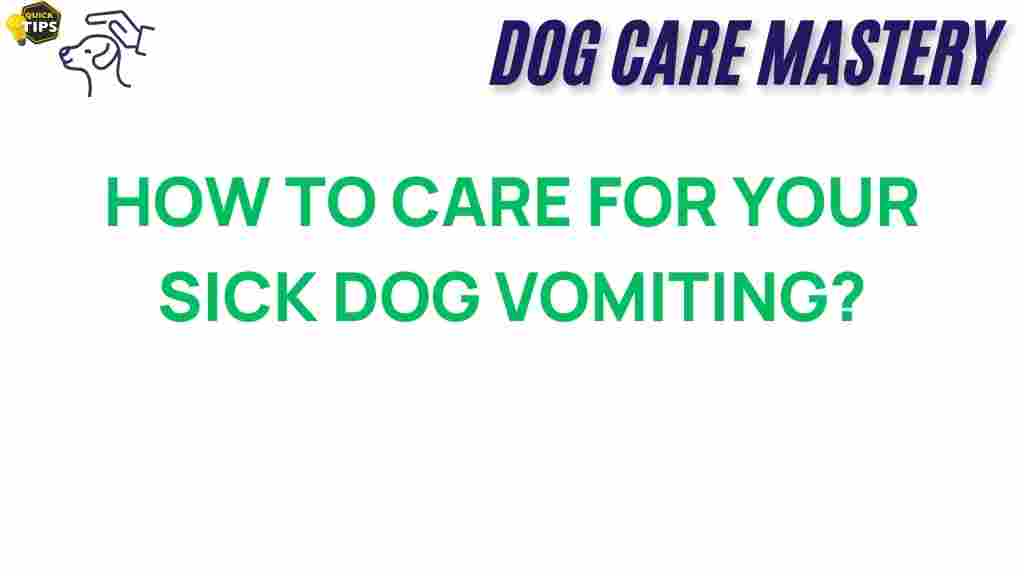Essential Tips for Caring for Your Sick Dog
As a devoted pet owner, nothing is more distressing than watching your beloved dog experience discomfort or illness. One common issue many dog owners face is vomiting. Understanding how to care for your sick dog can make a world of difference in their recovery and your peace of mind. In this comprehensive guide, we’ll delve into essential tips for caring for your dog when they are vomiting, ensuring that you are well-prepared to handle this situation.
Understanding Vomiting in Dogs
Vomiting in dogs can be caused by a variety of factors, including dietary indiscretion, infections, allergies, or more serious underlying health issues. Recognizing the signs and understanding the potential causes is crucial for effective care.
- Dietary indiscretion: Dogs are notorious for eating things they shouldn’t, which can lead to stomach upset.
- Infections: Viral or bacterial infections can cause vomiting and other gastrointestinal symptoms.
- Allergies: Food allergies or sensitivities may trigger vomiting in some dogs.
- Serious health issues: Conditions like pancreatitis, liver disease, or certain cancers can lead to vomiting.
Step-by-Step Process for Caring for Your Sick Dog
When faced with a vomiting dog, it’s important to act calmly and methodically. Here’s a step-by-step guide to help you care for your sick dog:
Step 1: Assess the Situation
Before taking any action, evaluate your dog’s condition:
- How many times have they vomited?
- What does the vomit look like (color, texture, presence of blood)?
- Are there any other symptoms (diarrhea, lethargy, loss of appetite)?
Documenting these details can be helpful when consulting your veterinarian.
Step 2: Remove Food and Water Temporarily
To give your dog’s stomach a chance to settle, remove food and water for about 12-24 hours. This fasting period can help reduce irritation in the digestive tract.
Step 3: Reintroduce Food Gradually
After the fasting period, if your dog has not vomited again, you can start reintroducing food:
- Start with a bland diet, such as boiled chicken and rice.
- Offer small portions every few hours instead of a full meal.
- Slowly transition back to their regular food over the next few days.
Step 4: Monitor Hydration
While it’s important to give your dog’s stomach a break, ensuring they stay hydrated is equally crucial. Here’s how to keep them hydrated:
- Offer small amounts of water frequently.
- Consider ice chips or ice cubes if they refuse to drink.
- If your dog continues to vomit, consult your veterinarian about electrolyte solutions.
Step 5: Watch for Warning Signs
Keep a close eye on your dog’s condition. If you notice any of the following warning signs, contact your veterinarian immediately:
- Vomiting persists for more than 24 hours.
- Vomiting contains blood or is brown/black in color.
- Your dog becomes lethargic or unresponsive.
- Signs of dehydration (dry gums, skin losing elasticity).
Troubleshooting Common Issues
Even with careful monitoring and care, you may encounter challenges while caring for your sick dog. Here are some troubleshooting tips:
1. Persistent Vomiting
If your dog continues to vomit after the initial fasting and bland diet, consider these steps:
- Ensure they aren’t eating anything harmful or indigestible.
- Look for signs of stress or anxiety that could be contributing to their vomiting.
- Consult your veterinarian for further diagnostic tests.
2. Refusal to Eat or Drink
If your dog refuses to eat or drink after the fasting period:
- Try enticing them with a small amount of their favorite food.
- Warm up their food slightly to enhance the aroma.
- If they still won’t eat or drink, consult your veterinarian.
3. Lethargy
Lethargy could indicate a serious condition. If your dog seems unusually tired:
- Encourage some light activity if they are willing.
- Keep them comfortable and observe any changes in their behavior.
- Contact your veterinarian if lethargy persists.
When to Seek Veterinary Care
While you can manage mild cases of vomiting at home, it’s essential to know when to seek professional help. Here are key indicators:
- Vomiting lasts more than 24 hours.
- Presence of blood in vomit.
- Severe abdominal pain or bloating.
- Signs of dehydration or shock.
- Changes in behavior, such as increased aggression or hiding.
For more information on when to take your dog to the vet, you can visit this resource.
Preventative Measures
Preventing vomiting in your dog is possible with a few proactive measures:
- Regular Vet Check-ups: Routine examinations can help identify underlying health issues early.
- Balanced Diet: Feed a nutritionally balanced diet appropriate for your dog’s age, size, and health status.
- Avoid Table Scraps: Limit the temptation to give your dog human food, which can upset their stomach.
- Supervise Outdoor Exploration: Keep an eye on your dog during walks to prevent them from eating harmful substances.
Conclusion
Caring for a sick dog can be a challenging and emotional experience. Understanding the causes of vomiting and knowing how to respond effectively can make a significant difference in your dog’s recovery. Follow the steps outlined in this guide, monitor your dog closely, and don’t hesitate to consult with your veterinarian if needed. By being proactive and attentive, you can ensure that your furry friend gets back to their happy, playful self in no time.
For more information on dog care, check out our other articles here.
This article is in the category Health and created by dogcaremastery Team
